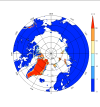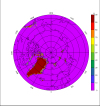Dear CTSM community,
Heidrun Matthes and I have been working on a CTSM evaluation study over the Arctic for the past year. We are using a "home-made" irregular domain and ERA5 data as forcing, after a "regular" spin-up of 15 years (that we will extend).
We may have found a problem with the snow depth represented by the model over some Arctic regions. In the first figure I have attached, you can see snow depth values (daily average of 22-02-1980) greater than 8m in the northern part of the Taymir Peninsula, and values greater than 12, 16m or more in the Sevemaya, Svalbard and Ellesmere islands, respectively.
We know that some of these areas are considered as glaciers by the model. However, if you look at the second figure attached, you can see that even in areas that are not considered glaciers, there are very large snow depth values in Figure 1.
When we compare the results of the ground temperature model to stations in these areas, we find a very large positive anomaly (model too warm) which could be explained by this unrealistically deep snow cover.
It is important to note that we did not find this contrast with a similar evaluation study using CLM4.5 (in press).
Have any of you encountered this same observation? Do you have any recommendations for us to resolve this issue?
I'm sorry about the on-the-fly mapping. I have attached the env_run.xml and user_nl_clm files from this run.
Thanks,
Adrien
Heidrun Matthes and I have been working on a CTSM evaluation study over the Arctic for the past year. We are using a "home-made" irregular domain and ERA5 data as forcing, after a "regular" spin-up of 15 years (that we will extend).
We may have found a problem with the snow depth represented by the model over some Arctic regions. In the first figure I have attached, you can see snow depth values (daily average of 22-02-1980) greater than 8m in the northern part of the Taymir Peninsula, and values greater than 12, 16m or more in the Sevemaya, Svalbard and Ellesmere islands, respectively.
We know that some of these areas are considered as glaciers by the model. However, if you look at the second figure attached, you can see that even in areas that are not considered glaciers, there are very large snow depth values in Figure 1.
When we compare the results of the ground temperature model to stations in these areas, we find a very large positive anomaly (model too warm) which could be explained by this unrealistically deep snow cover.
It is important to note that we did not find this contrast with a similar evaluation study using CLM4.5 (in press).
Have any of you encountered this same observation? Do you have any recommendations for us to resolve this issue?
I'm sorry about the on-the-fly mapping. I have attached the env_run.xml and user_nl_clm files from this run.
Thanks,
Adrien


